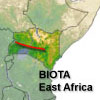 



Weather data
A large number of automatic weather stations has been implemented in the frame of the BIOTA AFRICA project by the Namibian National Botanical Research Institute (NBRI) and the Group "Biodiversity, Evolution and Ecology" (BEE) of the University of Hamburg. The website offers hourly updates of data and graphs of a large number of weather parameters.

|
 BIOTA East Africa - Workpackage(s)
BIOTA East Africa - Workpackage(s)
Subproject |
E03 - Regeneration of tropical trees - implications for forest conservation |
Workpackage |
WP6: Education and outreach |
Project leader(s) |
Dr. Winfred Musila
Dipl.-Biol. Henning Todt
Dipl.-Biol. Robert Gliniars |
Project description |
he aim of this work package is to transfer the knowledge of E03 that was gained within BIOTA to the local partners. An effective way to deliver this knowledge is by performing community based workshops.
In Kakamega, community workshops are planned which will cover tree nursery management, tree planting, seed collection, restoration strategies and forest biodiversity management. Our close cooperation with KEFRI Maseno through the director Dr. Mercy Gichora will be helpful in providing teaching on such issues. KEFRI Maseno has experience in such workshops with several nurseries in Nyanza and Western Province of Kenya. KEFRI Maseno has been our cooperation partner since 2005 for such training schemes and is interested in the advancement of especially the KEEP tree nursery and the local farmers.
In Nairobi, additional workshops are planned. One is going to be for the NMK staff on the usage of the installed ecological laboratory, the measurement methodologies and data handling (here a close cooperation with E15 in data management is established). The other workshop should be on the explanation of the adapted forest growth model FORMIND.
A tree trail was established in the first phase and is used by KEEP and KWS for education (local school children) and ecotourism purposes. This tree trail needs further improving and maintenance in the 3rd phase.
The on-farm forestry showcase will be installed with the assistance of KEEP using the concept of "rainforestation farming" technology. The chosen site will be a farmland in the village of Buyangu that is bordering the forest. Pioneer tree species will be planted first, based on formerly collected data. With time shade tolerant species and fruit plants will be gradually introduced. This creates a showcase for the local farmers as an example of on-farm-forestry. The aim is to replace destructive techniques and to save the biodiversity of the Kakamega Forest by giving the locals an alternative source of income. The reforestation scheme utilizes indigenous tree species. It is based on the premise that a farming system in the humid tropics based on indigenous tree species is more effective and sustainable then one based on exotic tree species. The villagers will benefit by the use of this technology by having crops and timber at the same time.
The production of manuals is an effective way to transfer knowledge to local stakeholders. The following manuals will be compiled in cooperation of other WP of this subproject: seedling identification, long-term monitoring, restoration, successful planting of tree species on farms. |
Keywords |
development of manuals, awareness raising |
Contribution to
cross-cutting themes (CCT) |
- Capacity building and information policy at local, national,and international levels (Theme5)
|
Link to Subproject |
E04
E15 |
|
|






 Go to the WeatherNet
Go to the WeatherNet BIOTA East Africa - Workpackage(s)
BIOTA East Africa - Workpackage(s)